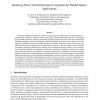Free Online Productivity Tools
i2Speak
i2Symbol
i2OCR
iTex2Img
iWeb2Print
iWeb2Shot
i2Type
iPdf2Split
iPdf2Merge
i2Bopomofo
i2Arabic
i2Style
i2Image
i2PDF
iLatex2Rtf
Sci2ools
IPPS
2005
IEEE
2005
IEEE
Reducing Power with Performance Constraints for Parallel Sparse Applications
Sparse and irregular computations constitute a large fraction of applications in the data-intensive scientific domain. While every effort is made to balance the computational workload in such computations across parallel processors, achieving sustained near machine-peak performance with close-to-ideal load balanced computation-to-processor mapping is inherently difficult. As a result, most of the time, the loads assigned to parallel processors can exhibit significant variations. While there have been numerous past efforts that study this imbalance from the performance viewpoint, to our knowledge, no prior study has considered exploiting the imbalance for reducing power consumption during execution. Power consumption in large-scale clusters of workstations is becoming a critical issue as noted by several recent research papers from both industry and academia. Focusing on sparse matrix computations in which underlying parallel computations and data dependencies can be represented by ...
Computations | Distributed And Parallel Computing | IPPS 2005 | Parallel Processors | Power Consumption |
Related Content
| Added | 25 Jun 2010 |
| Updated | 25 Jun 2010 |
| Type | Conference |
| Year | 2005 |
| Where | IPPS |
| Authors | Guangyu Chen, Konrad Malkowski, Mahmut T. Kandemir, Padma Raghavan |
Comments (0)

